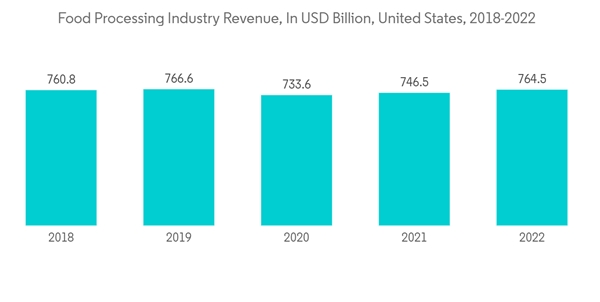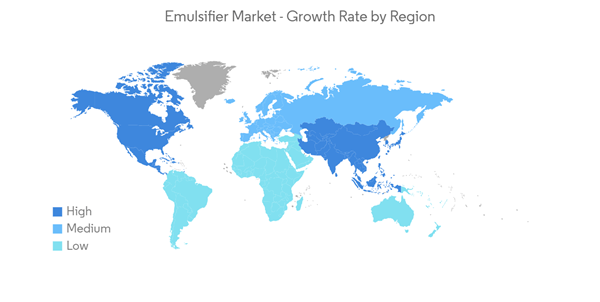The Emulsifier Market size is estimated at USD 9.59 billion in 2024, and is expected to reach USD 11.97 billion by 2029, growing at a CAGR of greater than 4% during the forecast period (2024-2029).
The COVID-19 pandemic had a negative impact on the emulsifiers market by disrupting production and distribution. This was due to factors such as difficulty obtaining raw materials, border-crossing restrictions, and limited access to labor. The resulting drop in supply and processing capacity led to worsening sales conditions and delayed production and market activities. However, the market has recovered steadily after that and is growing at a moderate pace, owing to increased consumption of emulsifiers from various industries post-pandemic.
The growing use of emulsifiers in food products and the increasing demand for packaged and processed foods are the main drivers of this market.
On the flip side, strict government regulations and the availability of close substitutes, such as enzymes, could hinder the growth of the emulsifiers market.
Growing research and development into emulsifiers as multipurpose agents in personal care and cosmetics is expected to create new opportunities for the market to grow.
Asia-Pacific region dominated the market across the globe, with the most significant consumption from countries such as China, India, and Japan. Being the largest consumers.
This product will be delivered within 2 business days.
The COVID-19 pandemic had a negative impact on the emulsifiers market by disrupting production and distribution. This was due to factors such as difficulty obtaining raw materials, border-crossing restrictions, and limited access to labor. The resulting drop in supply and processing capacity led to worsening sales conditions and delayed production and market activities. However, the market has recovered steadily after that and is growing at a moderate pace, owing to increased consumption of emulsifiers from various industries post-pandemic.
The growing use of emulsifiers in food products and the increasing demand for packaged and processed foods are the main drivers of this market.
On the flip side, strict government regulations and the availability of close substitutes, such as enzymes, could hinder the growth of the emulsifiers market.
Growing research and development into emulsifiers as multipurpose agents in personal care and cosmetics is expected to create new opportunities for the market to grow.
Asia-Pacific region dominated the market across the globe, with the most significant consumption from countries such as China, India, and Japan. Being the largest consumers.
Emulsifiers Market Trends
Increasing Demand from Food Products Segment
- Emulsifiers are surface-active agents or surfactants that stabilize an emulsion by increasing its kinetic stability. Emulsifier molecules have two ends: polar or hydrophilic (water-soluble) end and non-polar or hydrophobic (water-repellent) end.
- The increasing use of emulsifiers in food products such as cereals, ready-to-eat meals, infant and child nutrition products, snacks, desserts, and others is expected to increase the demand for emulsifiers globally.
- As technology advances, industrial businesses are turning to new sources of emulsifiers to improve product quality, boost efficiency, and reduce processing time. Emulsion technology has been used in the food industry for decades to produce a wide range of products, such as homogenized milk, creams, dips, dressings, sauces, desserts, and toppings.
- As per IBEF (India Brand Equity Foundation), the Indian food processing industry has grown rapidly in the past 5 years, averaging 8.3% annual growth. With a market size of USD 866 billion in 2022, the food industry will play a key role in emulsifier consumption.
- Furthermore, with the increase in consumption of functional food products, various companies are coming up with specialty ingredients enriched in protein, amino acids, and omega-3 fatty acids in milk-based products, sauces, spreads, baked foods, breakfast cereals, and baby foods. With robust demand for specialty ingredients with improved nutritional properties, the need for additives like emulsifiers will increase during the forecast period.
- As per the National Food Management Center of China Light Industry, despite facing the pandemic in the past, the food sector has shown strong momentum and resilience in 2022 and is expected to grow at this pace in 2023.
- As per CDIC (China Daily Information Co.), the Chinese food market registered steady growth in 2022 and is expected to maintain the same growth in 2023. The Chinese food companies reported that the revenue in 2022 peaked at over CNY 9.8 trillion (approx. USD 1.3 trillion), making an annual increase of 5.6% over the previous year.
- Owing to all the factors mentioned above for an emulsifier, its market is expected to increase over the forecast period.
Asia-Pacific Region to Dominate the Market
- Asia-Pacific region is expected to dominate the market for emulsifiers during the forecast period. In countries like China and India, owing to the growing population and increasing disposable income, the demand for emulsifiers has been increasing in the region.
- The increasing usage of emulsifiers, namely lecithin, in food products like chocolate and confectionery products, which provide various advantages during processing and storage, is projected to increase the demand for emulsifiers in the region.
- The food products segment is projected to hold more than 40% of the emulsifier market in the region, and the personal care & cosmetics segment is projected to hold the second-largest share with more than 25% of the emulsifier market in the region.
- The usage of emulsifiers in the personal care & cosmetics industry helps in providing better mixing of water with oils. Cosmetics products, namely lotions and creams, utilize both; the perfect balance between oil and water needs to be attained to maintain the homogeneity of these products, which is done using emulsifiers.
- In China, the revenue from the cosmetics industry in the year 2023 is projected to reach USD 70.65 billion.
- The factors above, coupled with government support, are contributing to the increasing demand for emulsifiers during the forecast period.
Emulsifiers Industry Overview
The emulsifier market is highly fragmented. The major players (not in any particular order) include BASF SE, DuPont, Kerry Inc., Akzo Nobel N.V., and Corbion, among others.Additional Benefits:
- The market estimate (ME) sheet in Excel format
- 3 months of analyst support
This product will be delivered within 2 business days.
Table of Contents
1 INTRODUCTION
4 MARKET DYNAMICS
5 MARKET SEGMENTATION (Market Size In Value)
6 COMPETITIVE LANDSCAPE
7 MARKET OPPORTUNITIES AND FUTURE TRENDS
Companies Mentioned (Partial List)
A selection of companies mentioned in this report includes, but is not limited to:
- ADM
- Akzo Nobel N.V.
- BASF SE
- Cargill, Incorporated
- Clariant
- Corbion
- DSM
- DuPont
- Evonik
- Kerry Inc
- Lonza
- Palsgaard
- Solvay
- Stepan Company
- The Lubrizol Corporation










